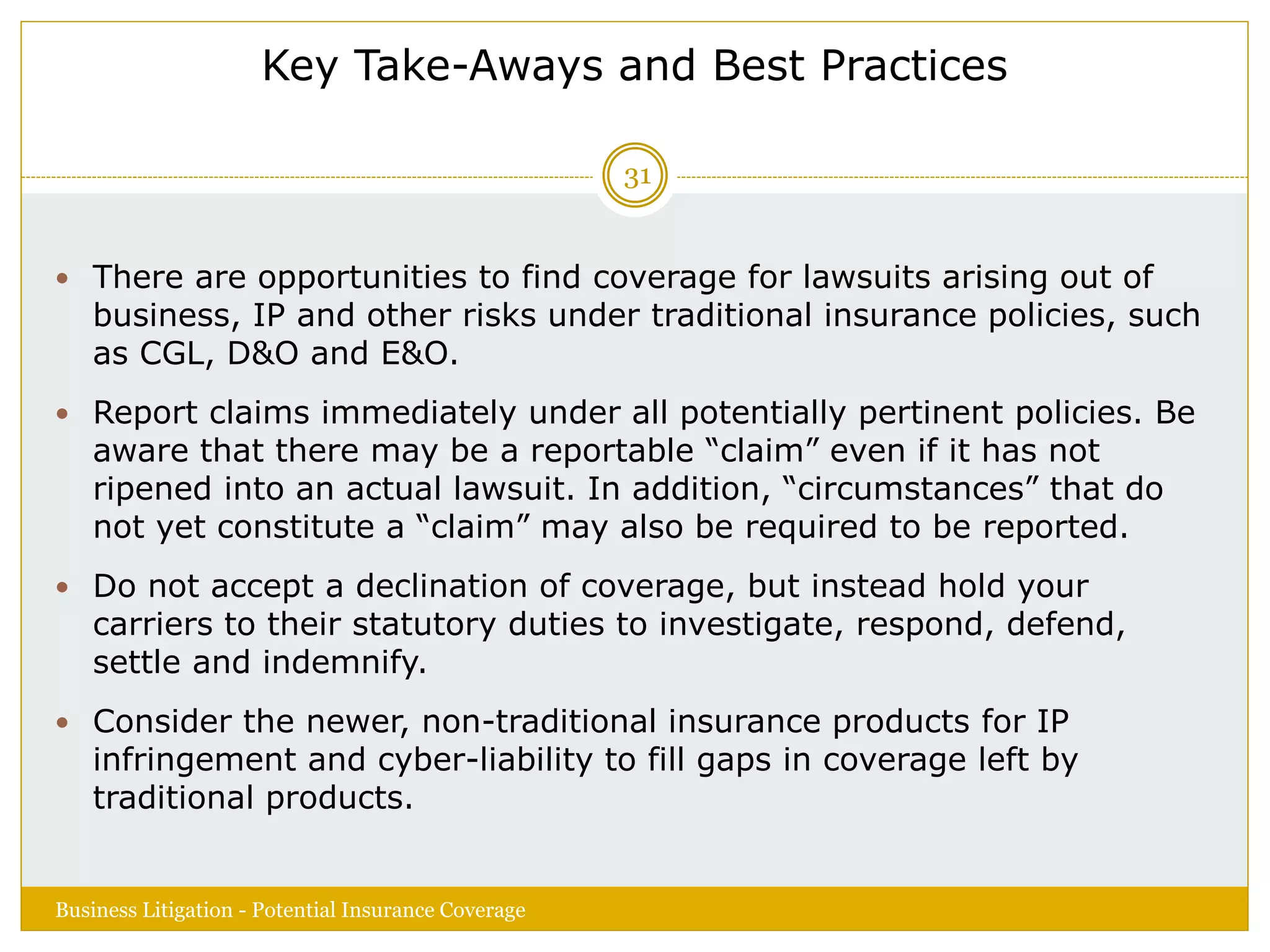The document discusses potential insurance coverage for business litigation. It provides an overview of liability insurance, explaining that it protects against legal claims and pays for both legal costs and damages if found liable. It also details the broad duty of insurance companies to defend policyholders in lawsuits. The document outlines important features of liability insurance policies and case law establishing insurers' defense obligations, even for uncovered claims or where exclusions may apply. It notes that coverage can sometimes be found in counterintuitive situations involving various types of legal claims.
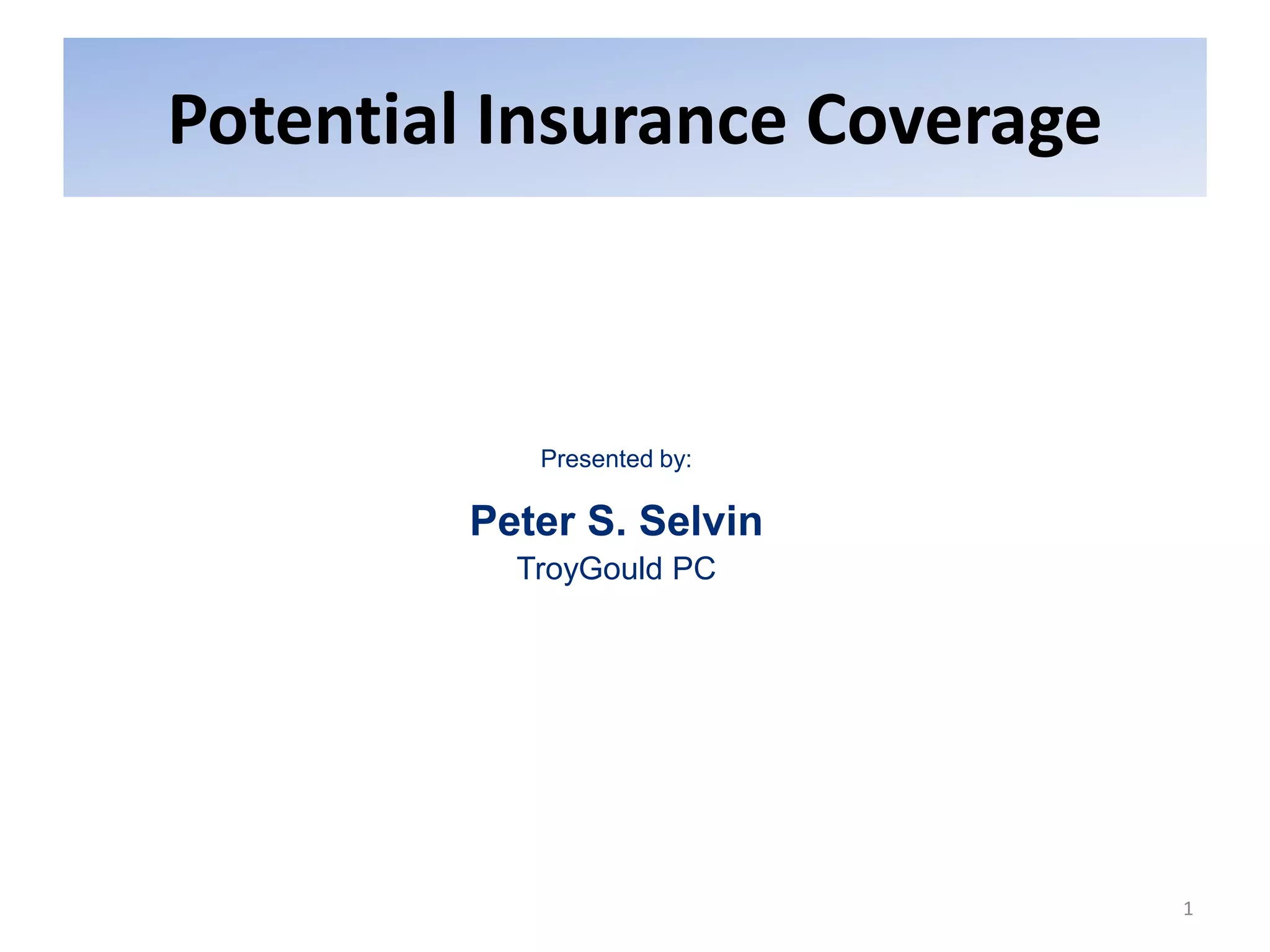
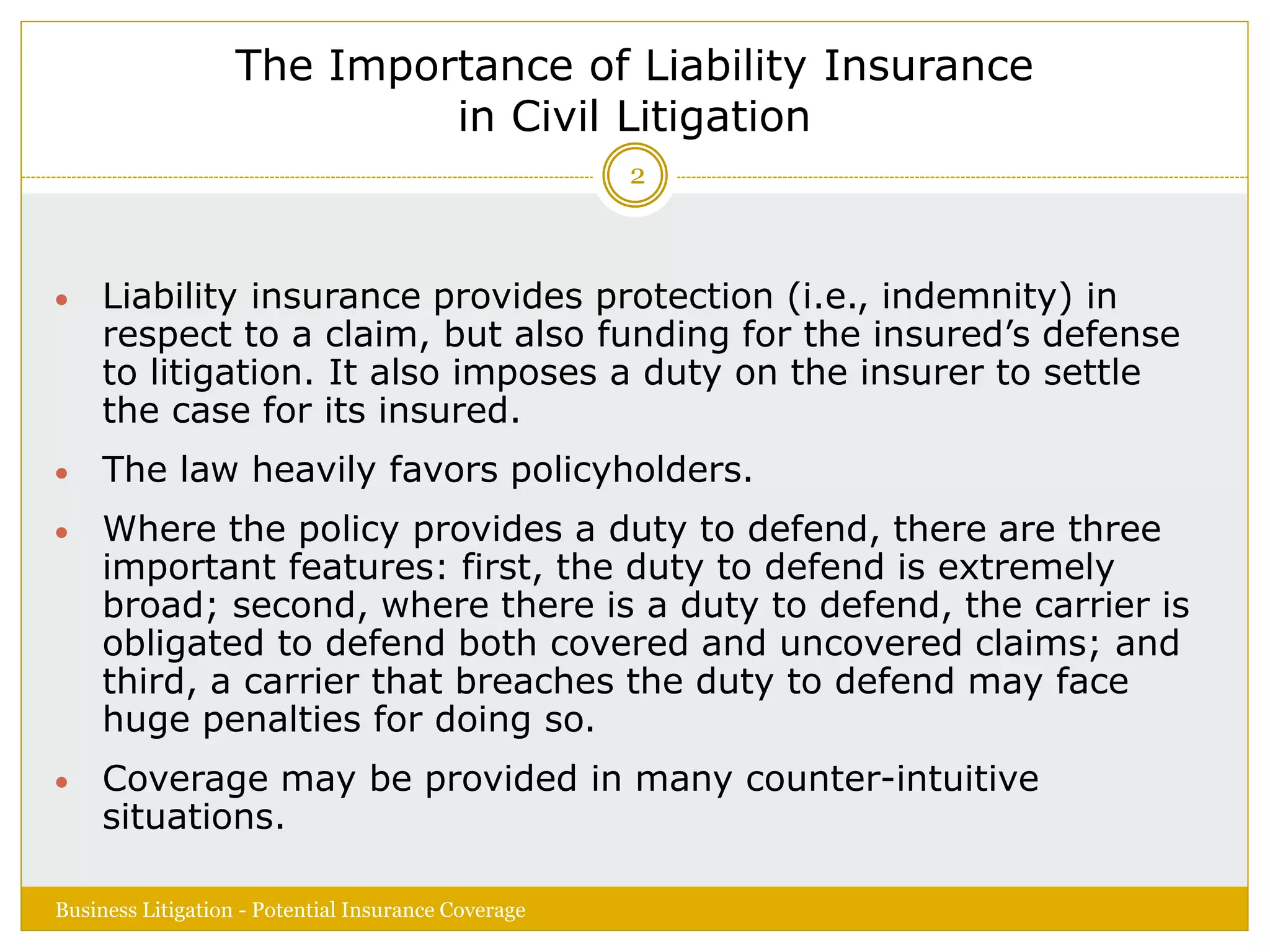
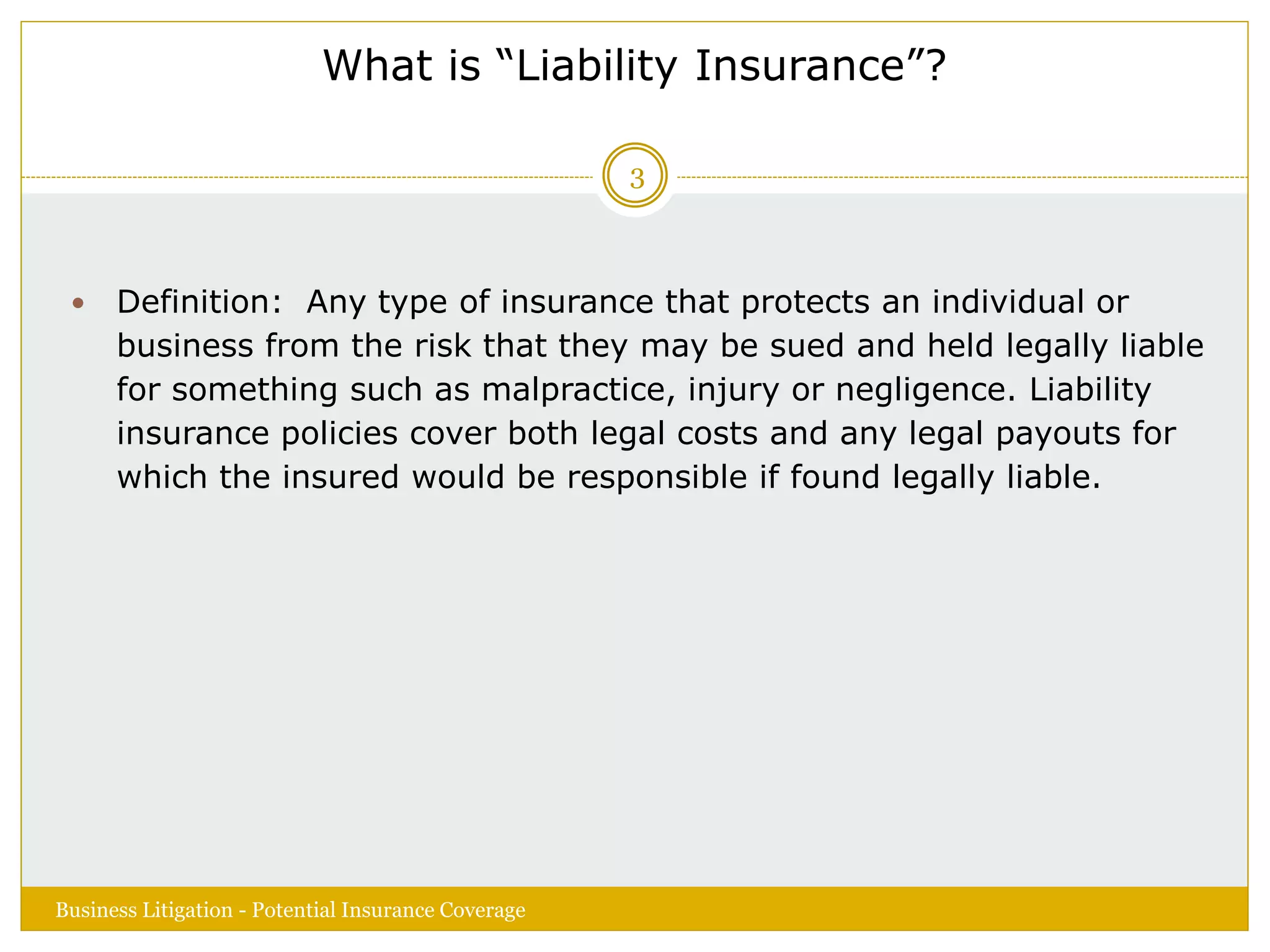
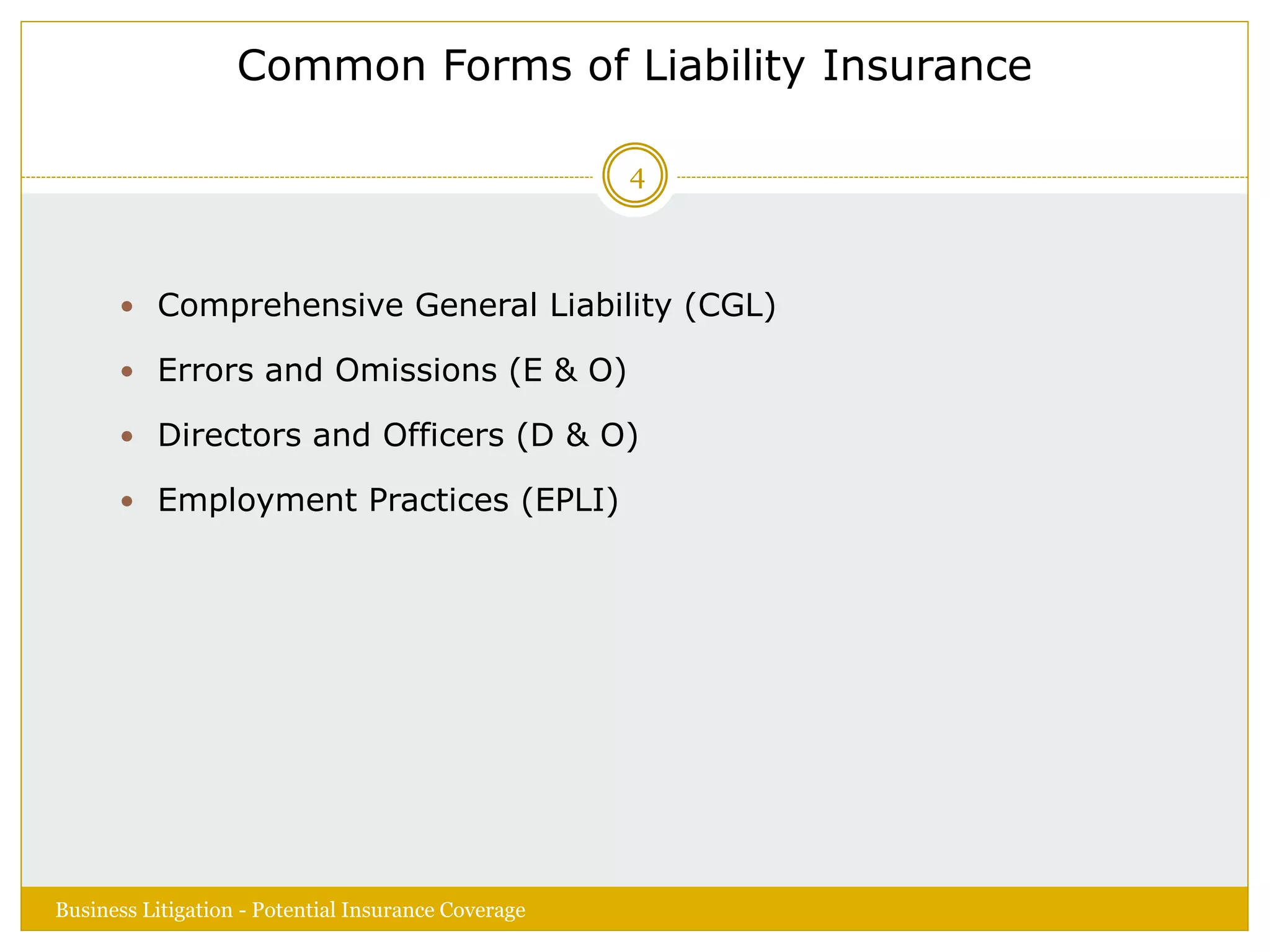
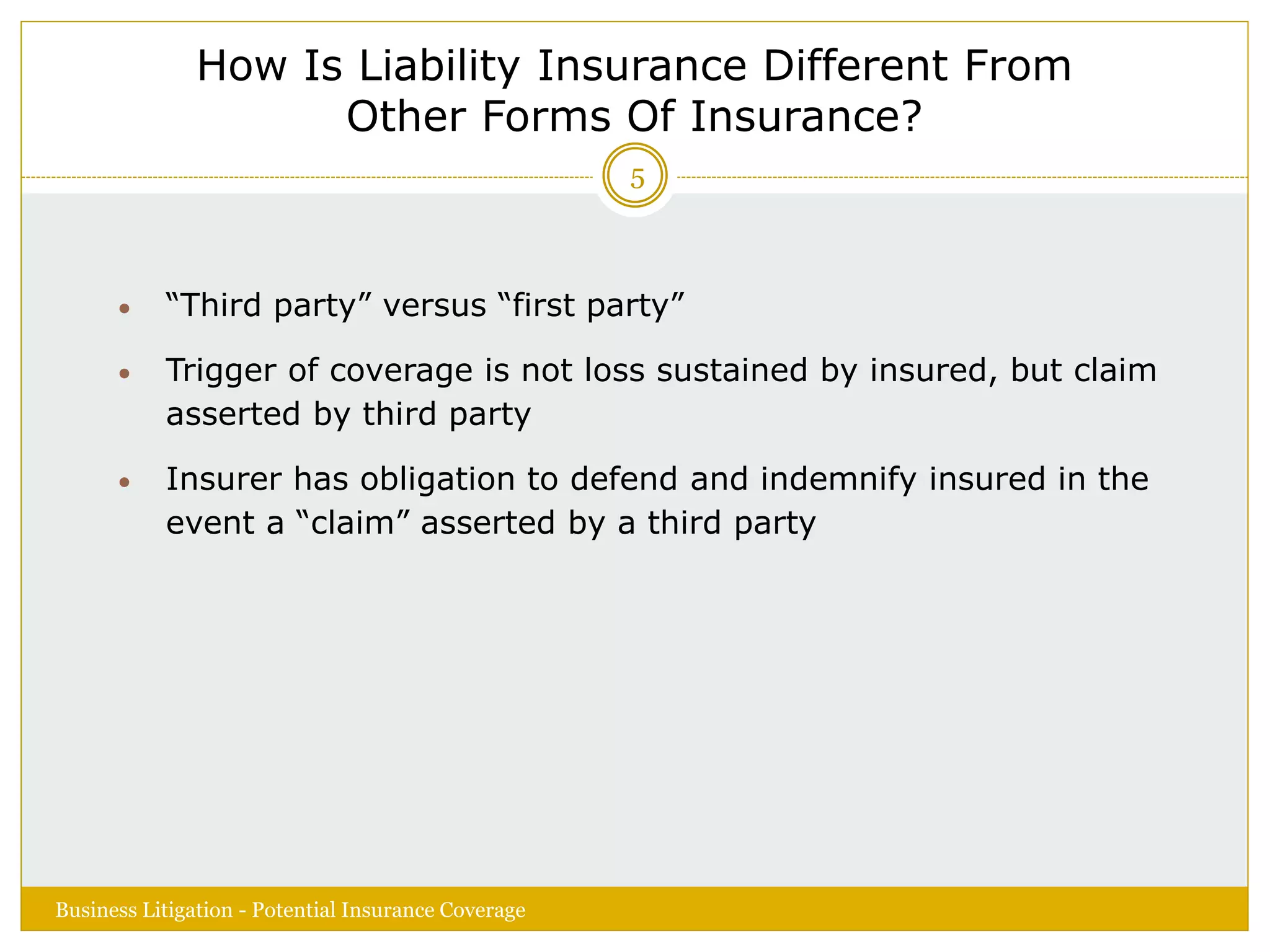
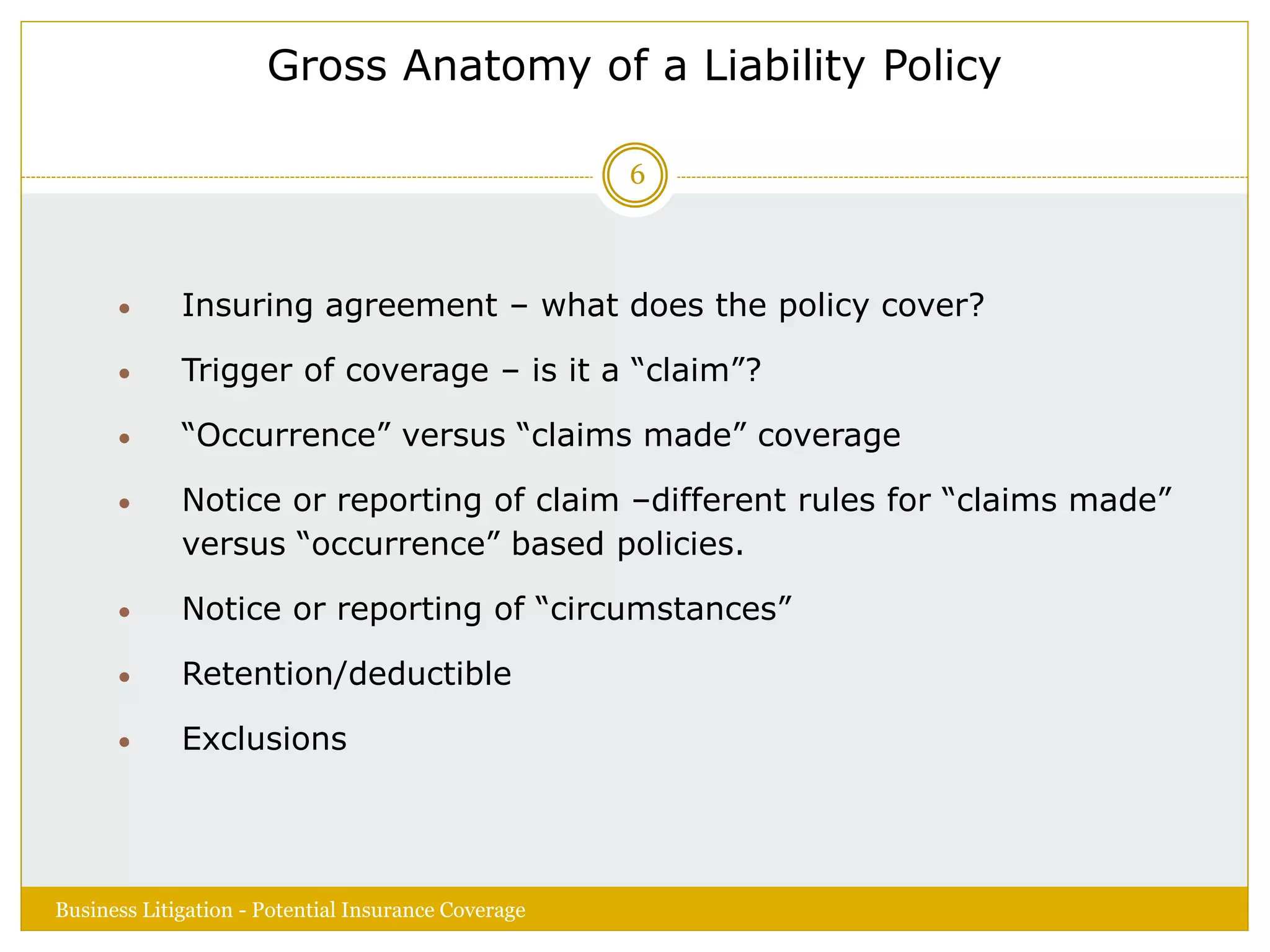
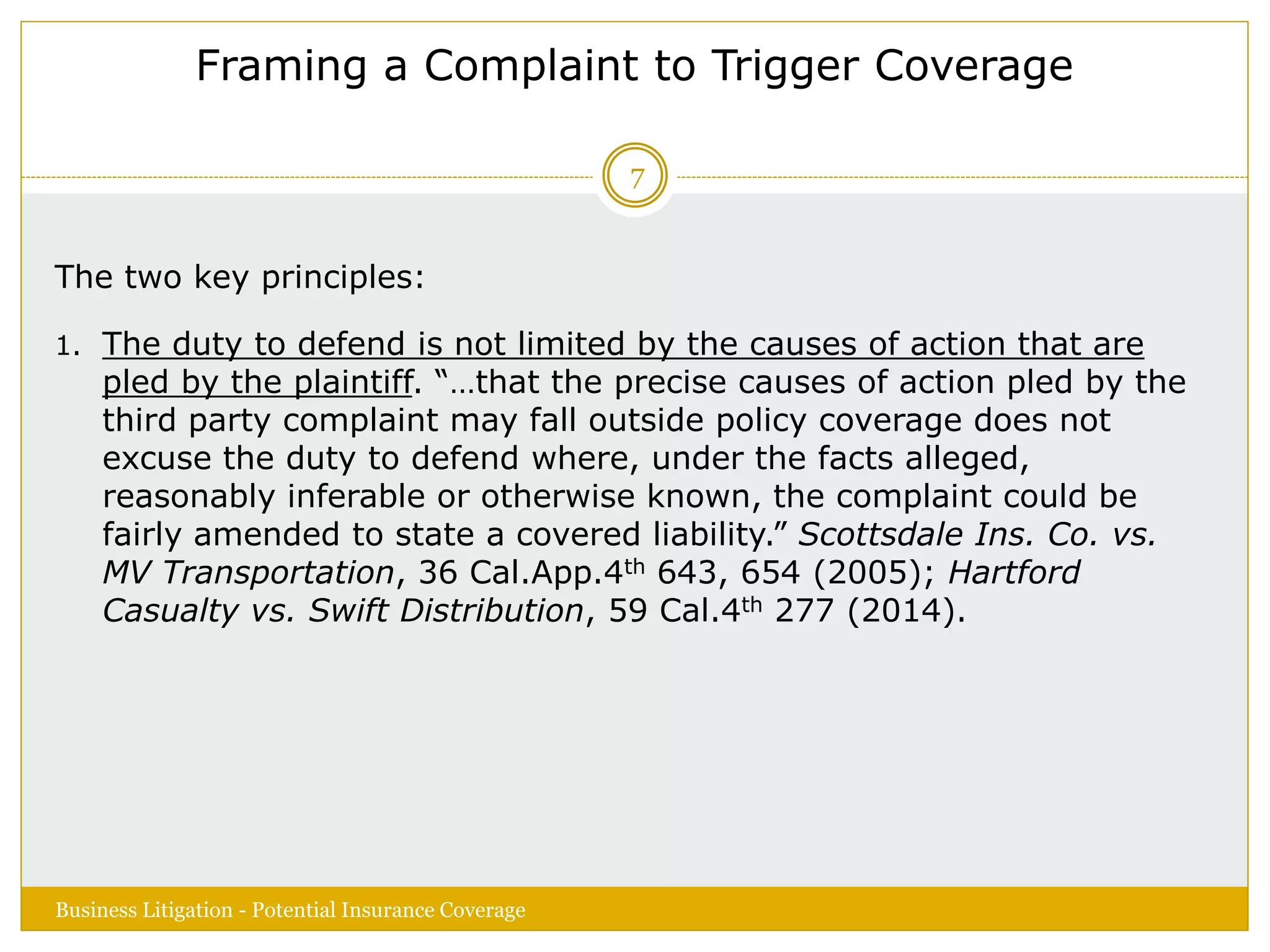
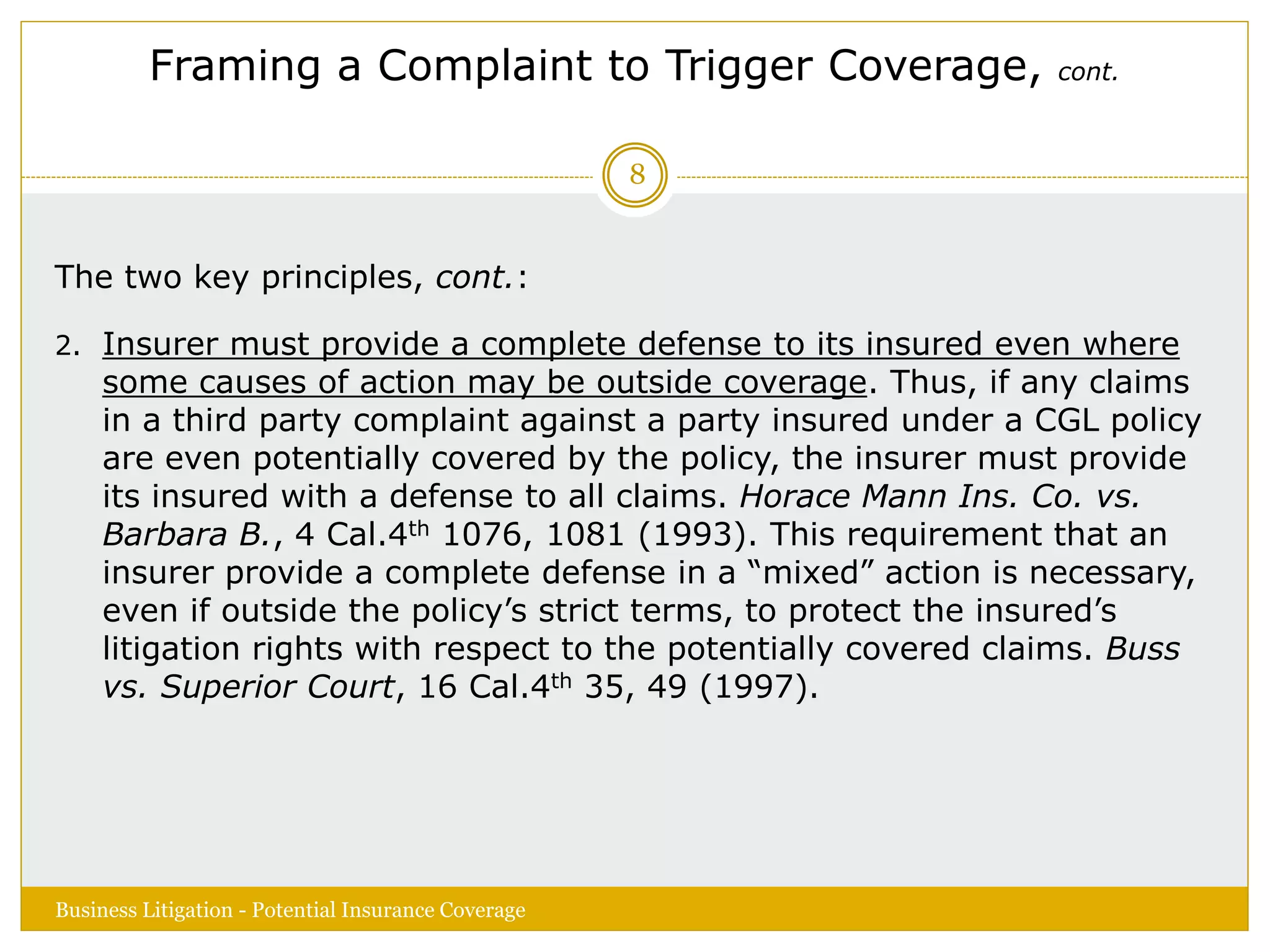
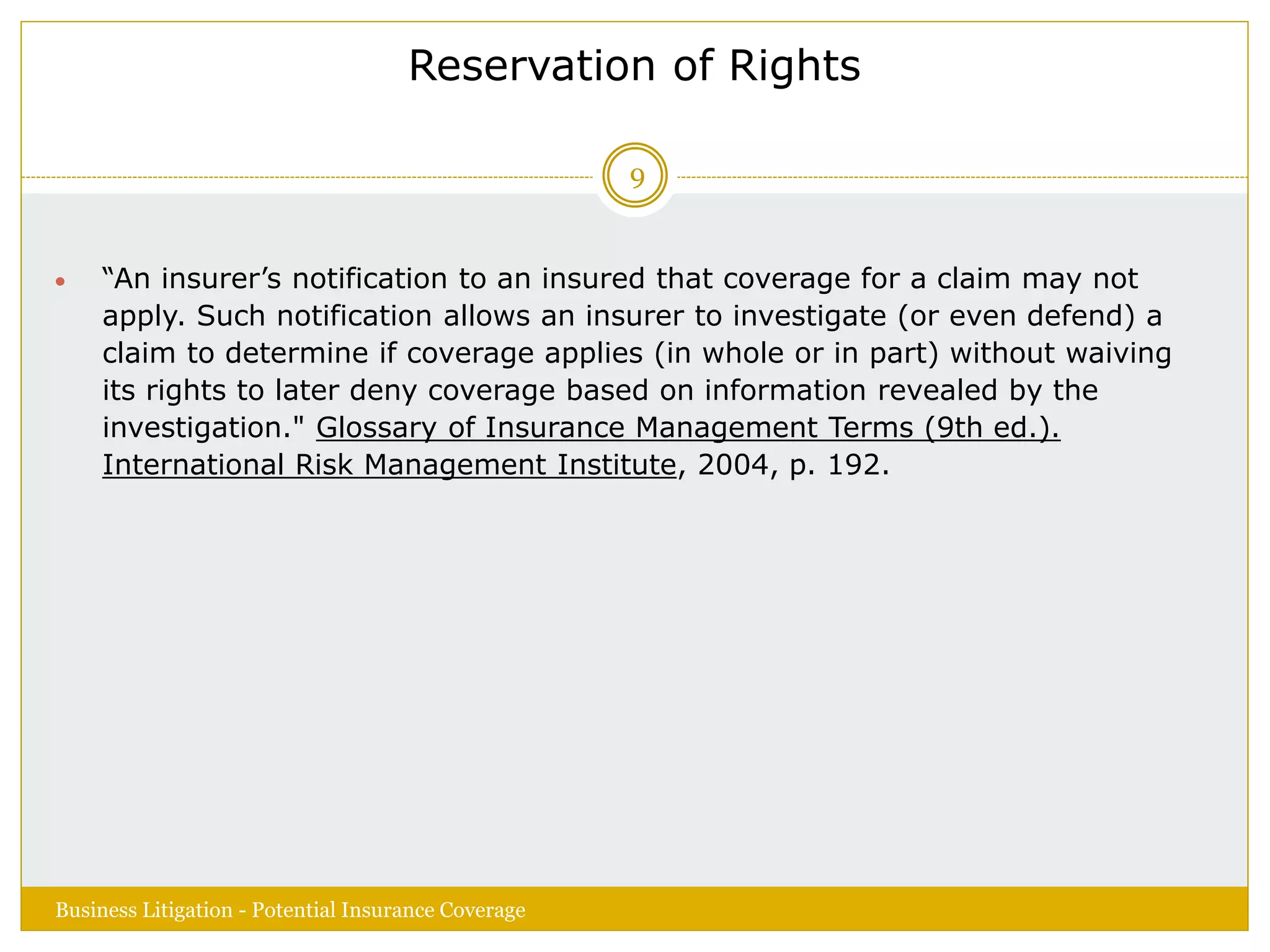
![Reservation of Rights, cont.
"An insured is entitled to know early in the litigation process whether the
insurer intends to honor [its] duty [to defend] in order that the insured may
take steps to defend himself. If in fact the insurer undertakes that defense
the insured may reasonably rely upon the nonexistence of policy defenses. To
hold otherwise would allow the insurer to conduct the defense of the action
without the knowledge of the insured that a conflict of interest exists
between itself and the insurer. The conflict is that the insurer retains a policy
defense which would relieve the insurer of all liability while simultaneously
depriving the insured of the right to conduct his own defense. It is the
reliance of the insured upon the insurer's handling of the defense and the
subsequent prejudice which gives rise to an estoppel in the first instance
against the insurer from raising policy defenses.“ Penn-America Ins Co. v.
Sanchez, 220 Ariz. 7, 202 P. 3d 472 (2008).
Business Litigation - Potential Insurance Coverage
10](https://image.slidesharecdn.com/d14c790d-eea7-4d96-99a2-c8f1aa71ea31-161012172533/75/Selvin_Potential-Insurance-Coverage-10-2048.jpg)
![The Duty to Defend
Under Civil Code § 2778(4), the duty to defend is implied in all liability
insurance contracts unless the policy clearly and unambiguously excludes
such a duty. One of the most basic cornerstones of modern insurance law is
that the duty to defend is broader than the duty to indemnify. Gray v. Zurich
Ins. Co., 65 Cal. 2d 263 (1966).
In order to trigger an insurer’s duty to defend, “the insured need only show
that the underlying claim may fall within policy coverage.” Montrose Chemical
Corp. v. Superior Court, 6 Cal. 4th 287, 300 (1993). “[T]he insurer must
prove it ‘cannot.’” Montrose, 6 Cal. 4th at 300 (1993). This is so even if a
claim is “insubstantial” and would not support an award of damages. Horace
Mann Ins. Co. v. Barbara B., 4 Cal. 4th 1076, 1086 (1993).
By contrast, the duty to indemnify is governed by facts established at trial.
City of Laguna Beach v. Mead Reinsurance Corp., 226 Cal. App. 3d 822, 829-
830 (1990). An insurer is obligated to indemnify against liability only if facts
proven at trial show a covered claim. (California Insurance Law Handbook
(2011) at § 46:1)
Business Litigation - Potential Insurance Coverage
11](https://image.slidesharecdn.com/d14c790d-eea7-4d96-99a2-c8f1aa71ea31-161012172533/75/Selvin_Potential-Insurance-Coverage-11-2048.jpg)
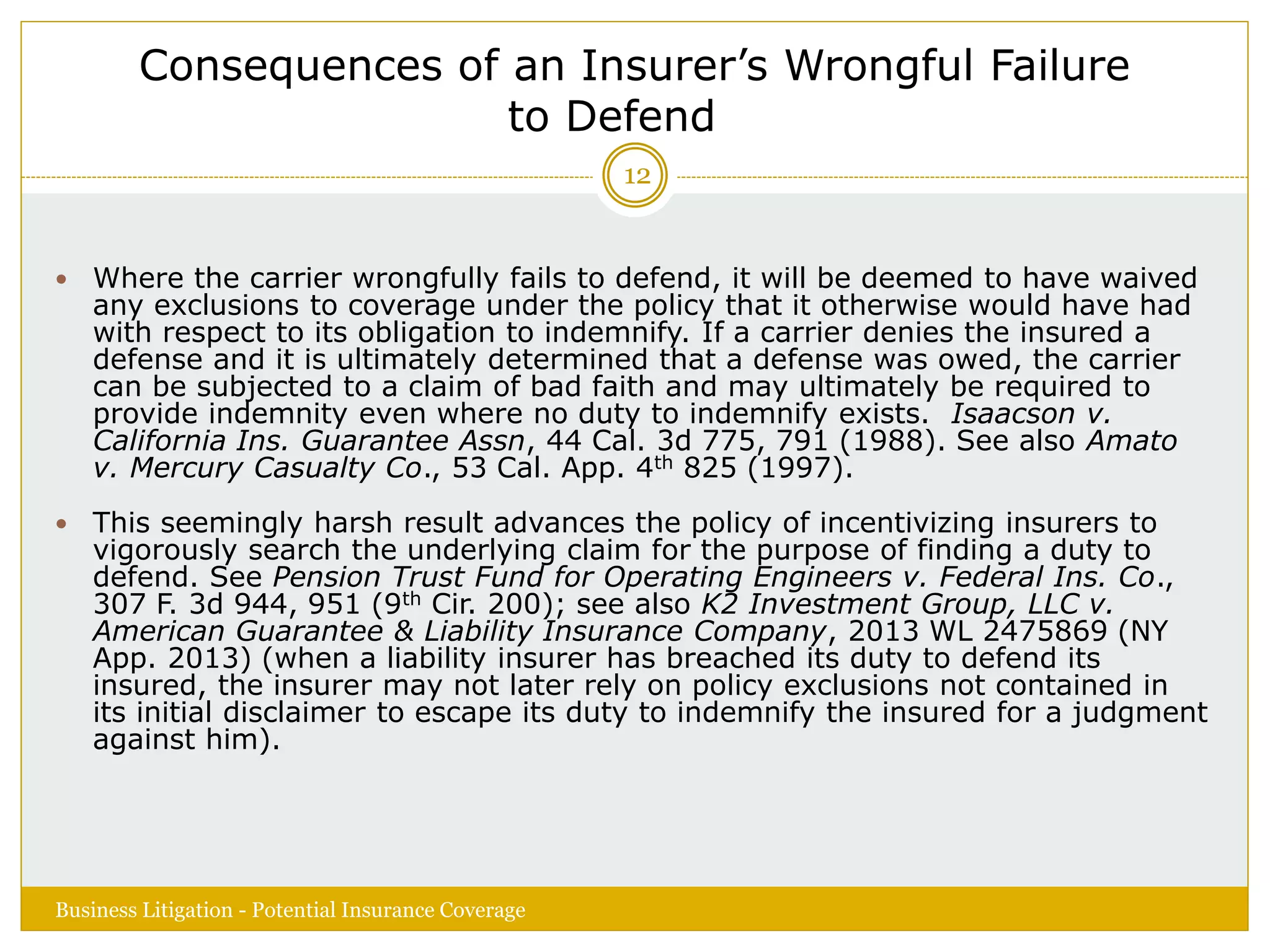
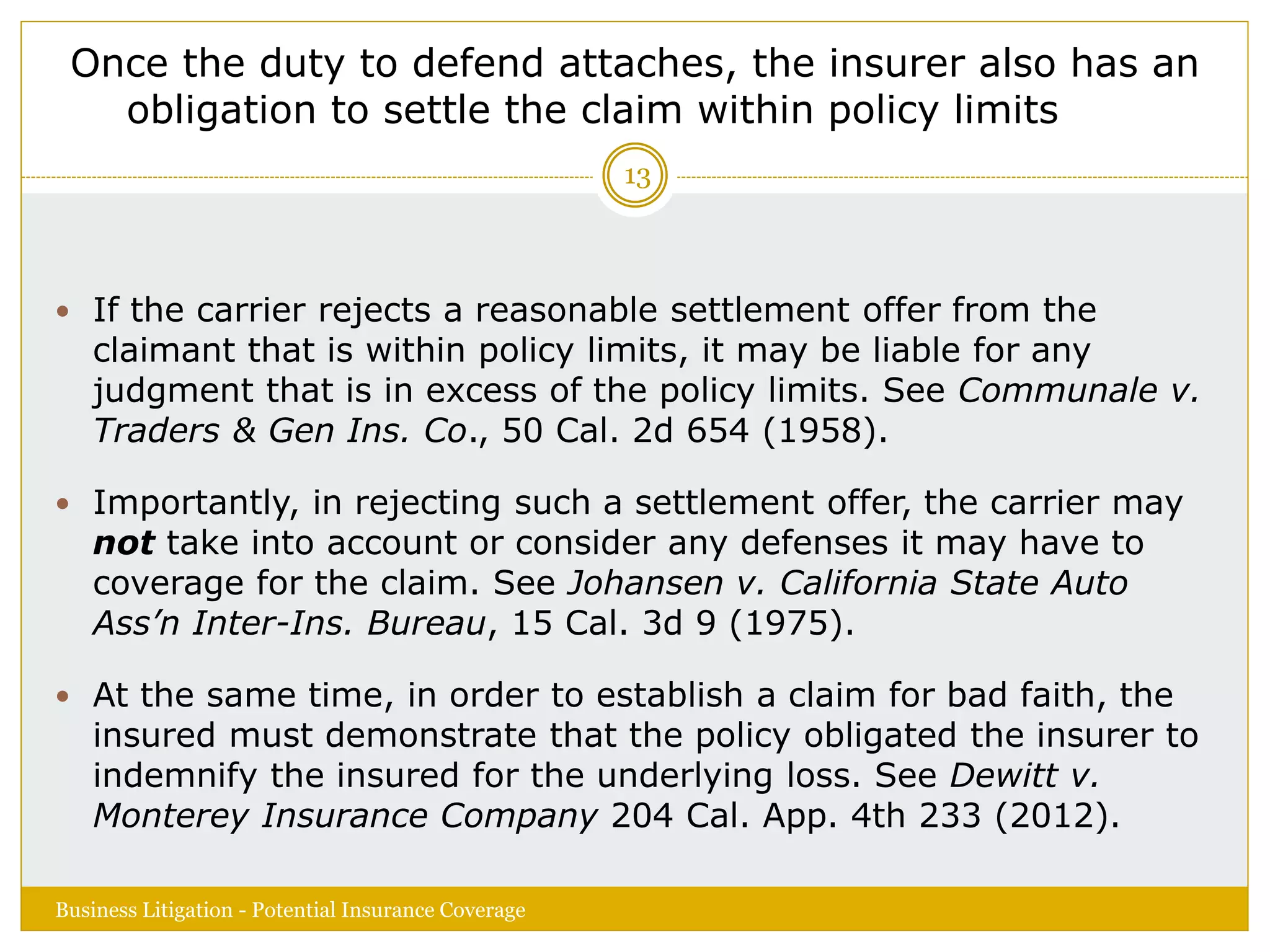
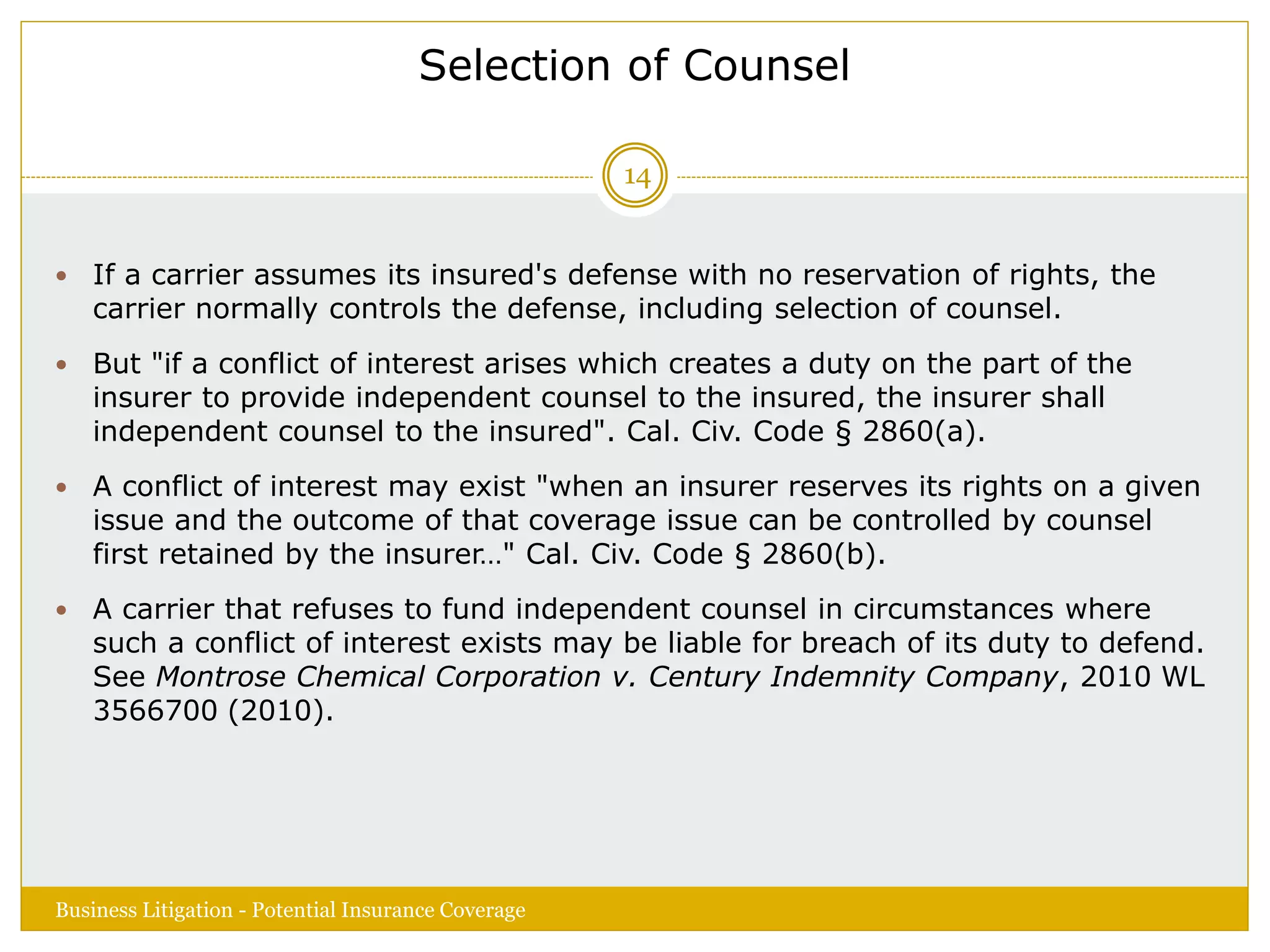
![“Cumis” Counsel’s Direct Exposure for Fees
Unnecessary for the Insureds’ Defense
In 2015, the California Supreme Court decided in Hartford Casualty
vs. J. R. Marketing, LLC, 61 Cal.4th 998 (2015) that an insurer may
seek reimbursement directly from so-called “Cumis” counsel for fees
attributable to time that was fraudulent or was otherwise manifestly
useless and wasteful when incurred.
“Cumis counsel have been unjustly enriched at the insurer’s
expense [and they] provide no convincing reason why they
should be absolutely immune from liability for enriching
themselves in this fashion.”
Business Litigation - Potential Insurance Coverage
15](https://image.slidesharecdn.com/d14c790d-eea7-4d96-99a2-c8f1aa71ea31-161012172533/75/Selvin_Potential-Insurance-Coverage-15-2048.jpg)
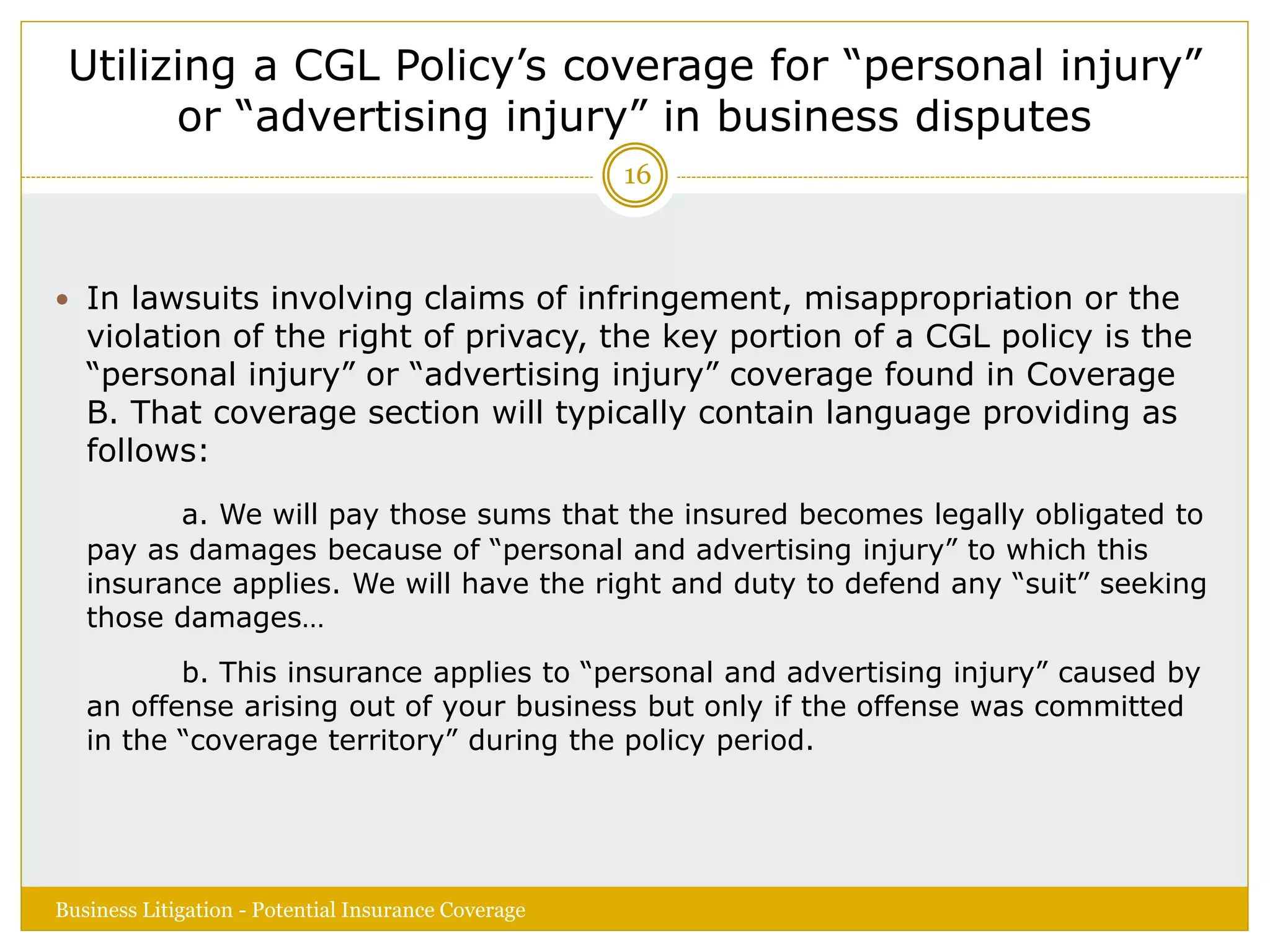
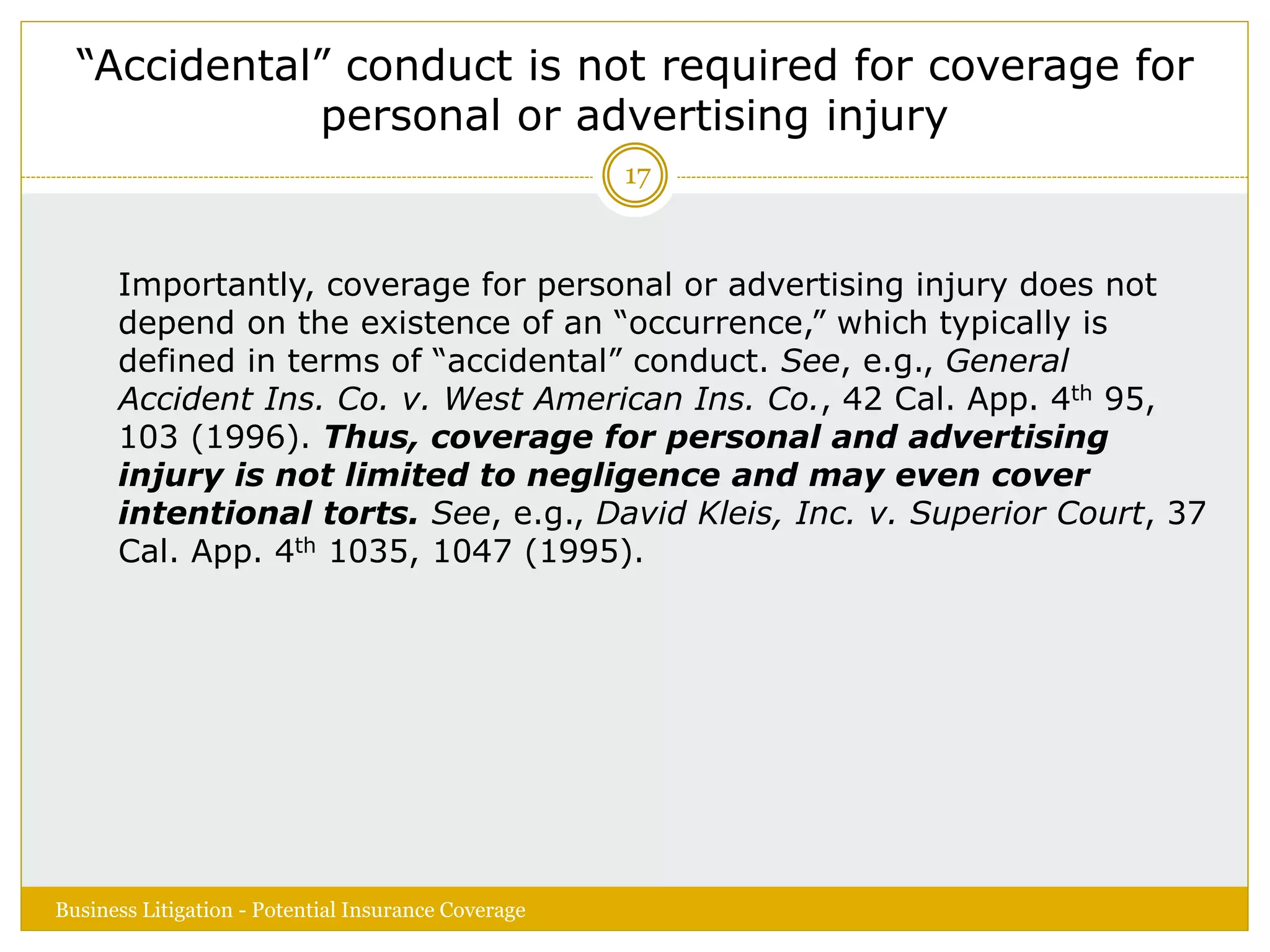
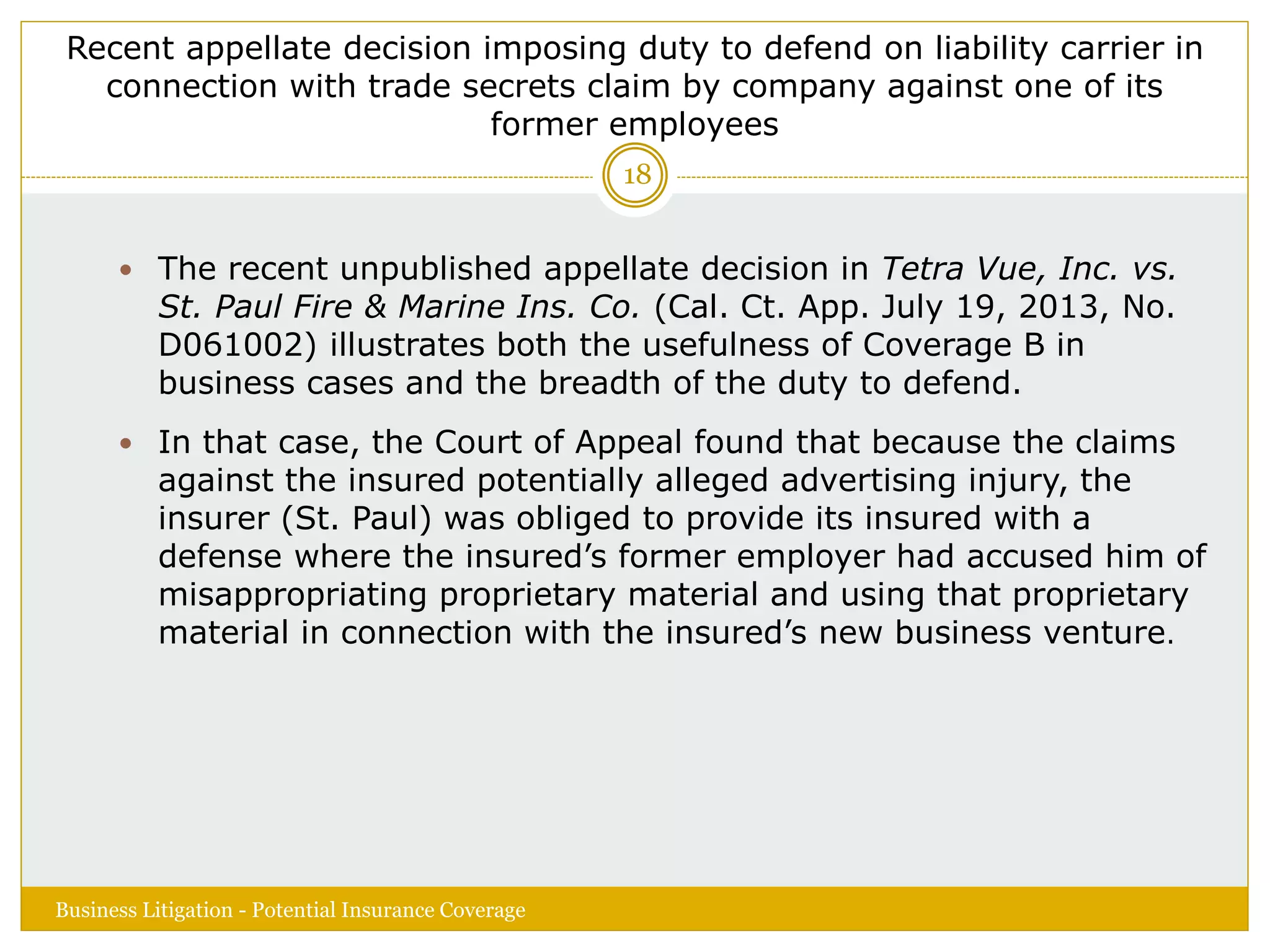
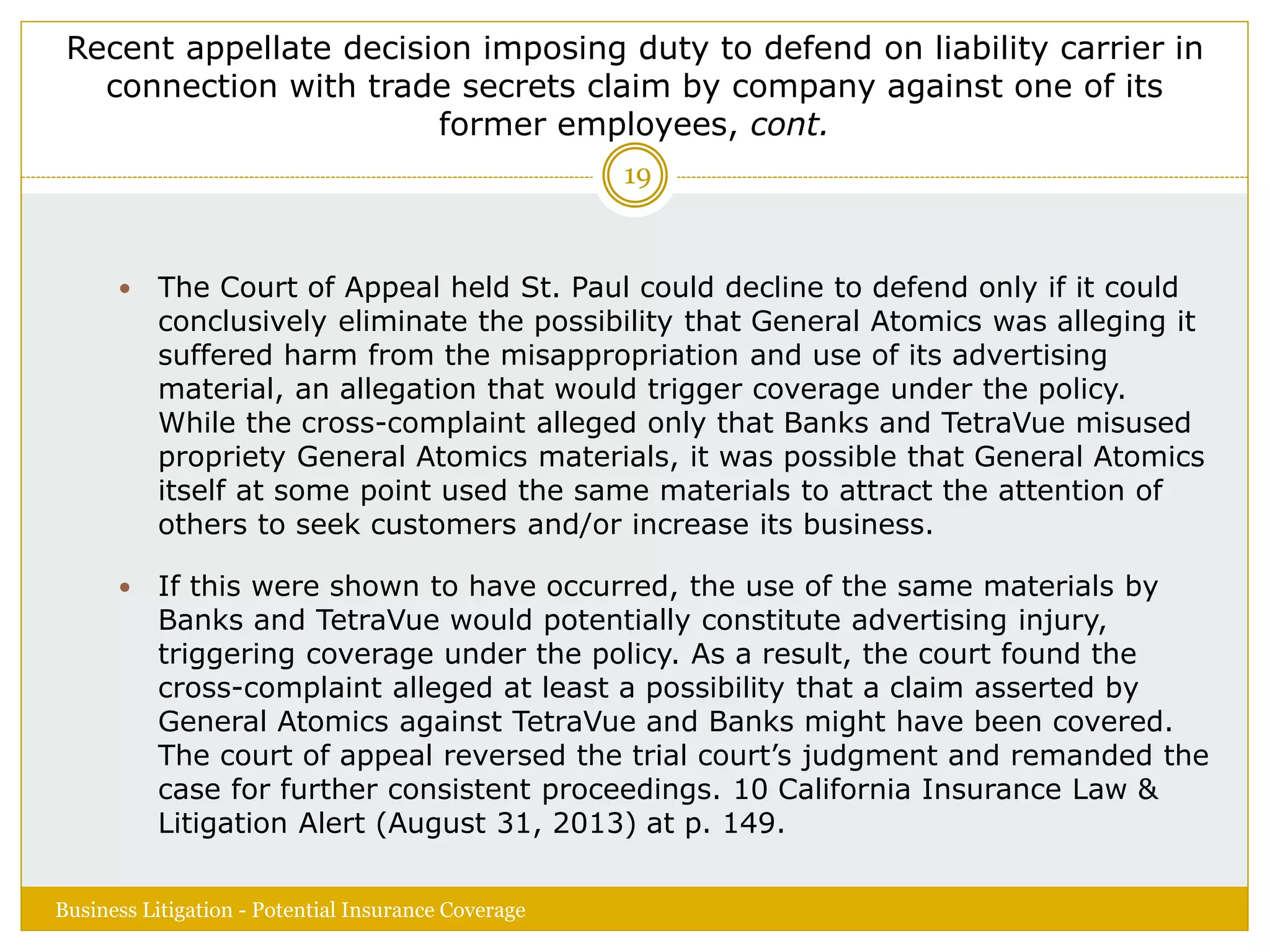
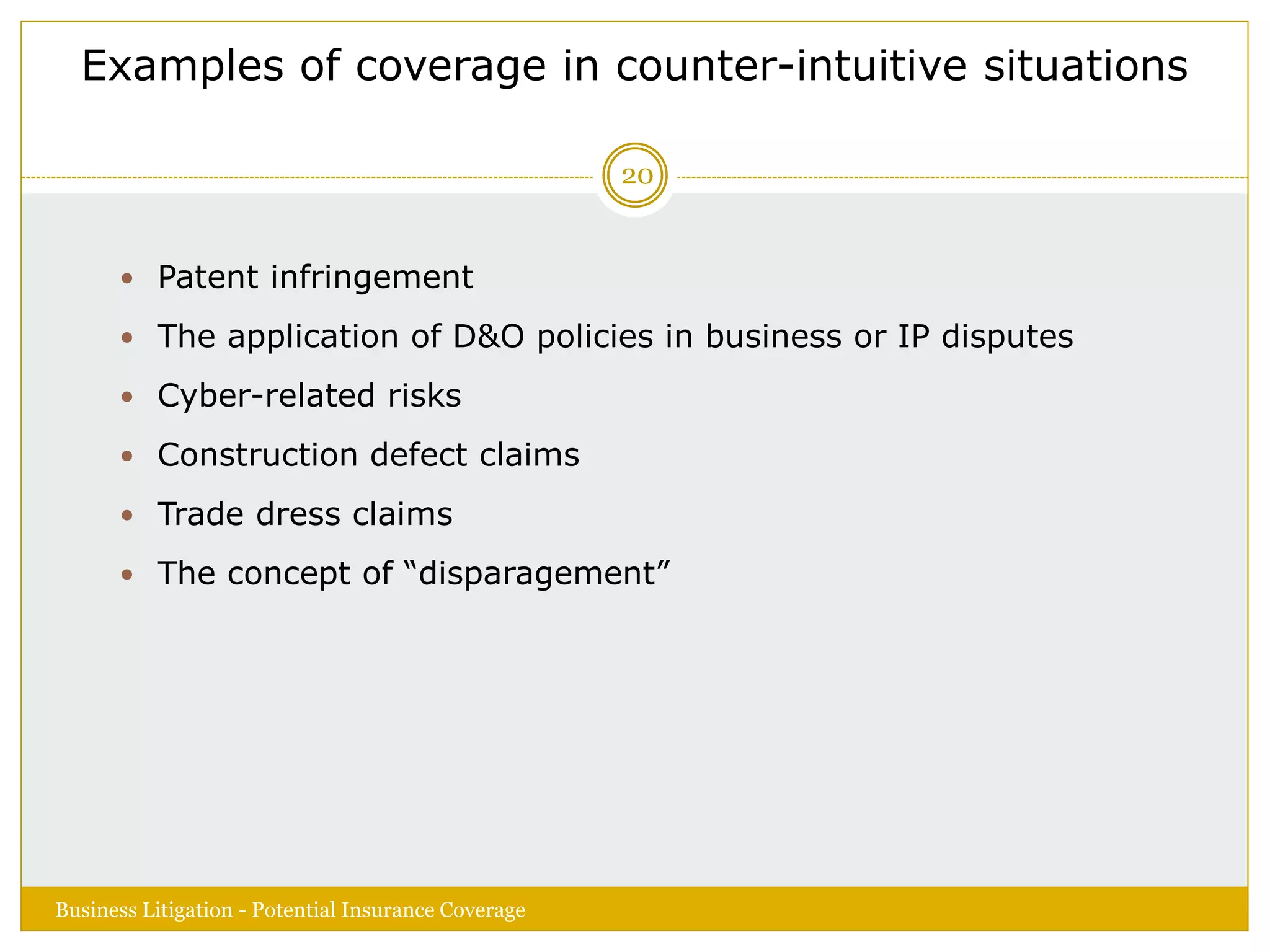
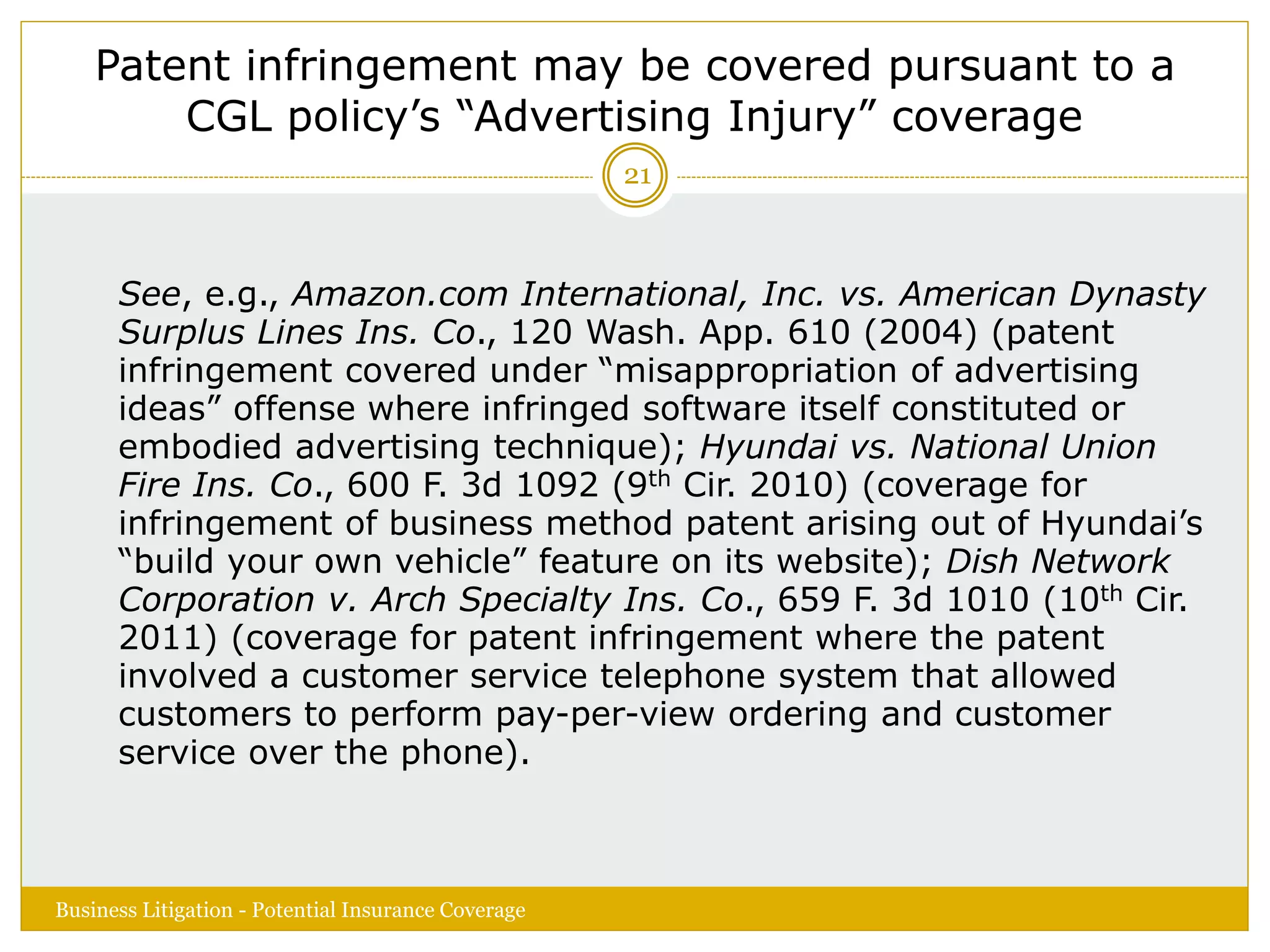
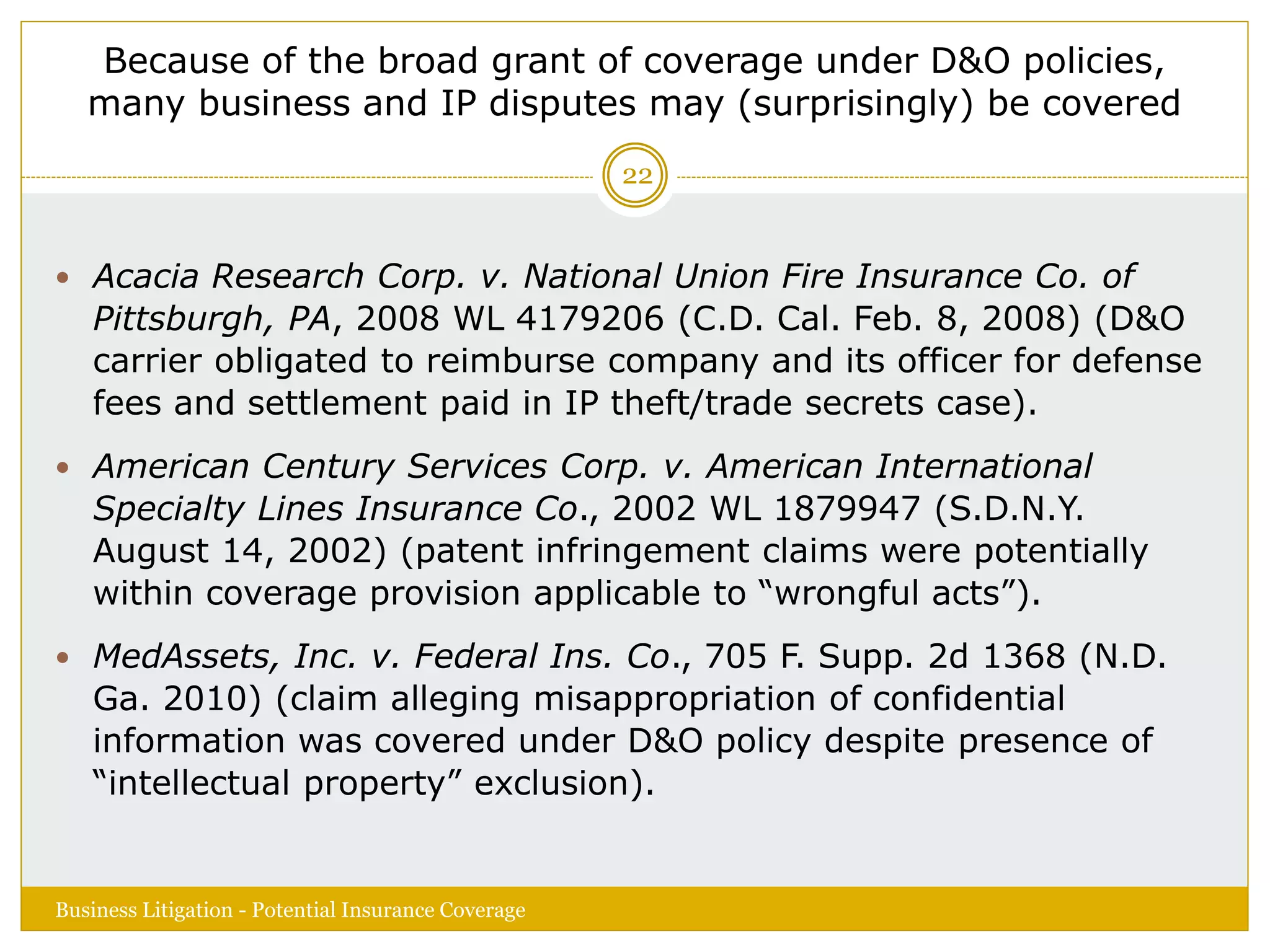
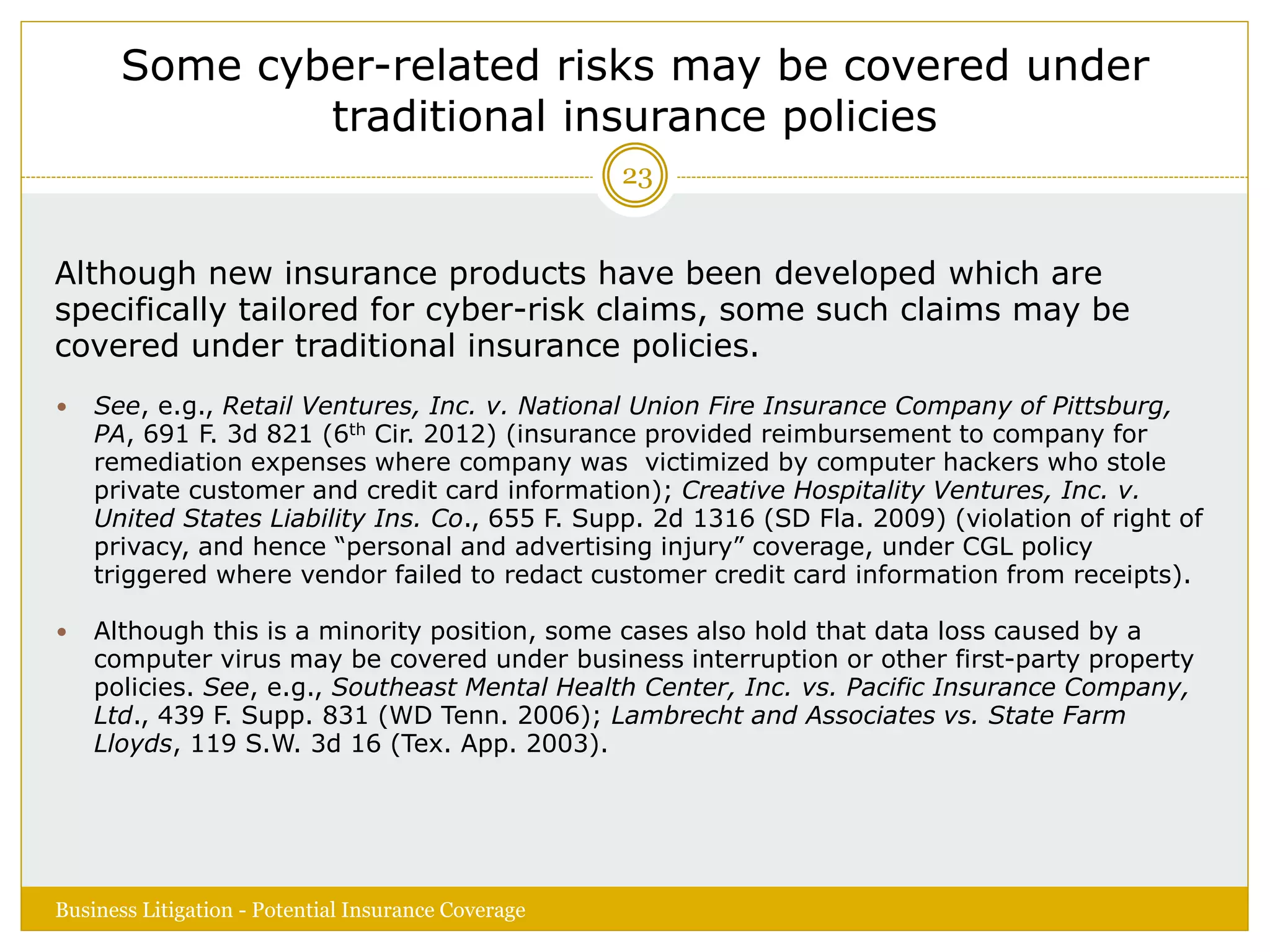

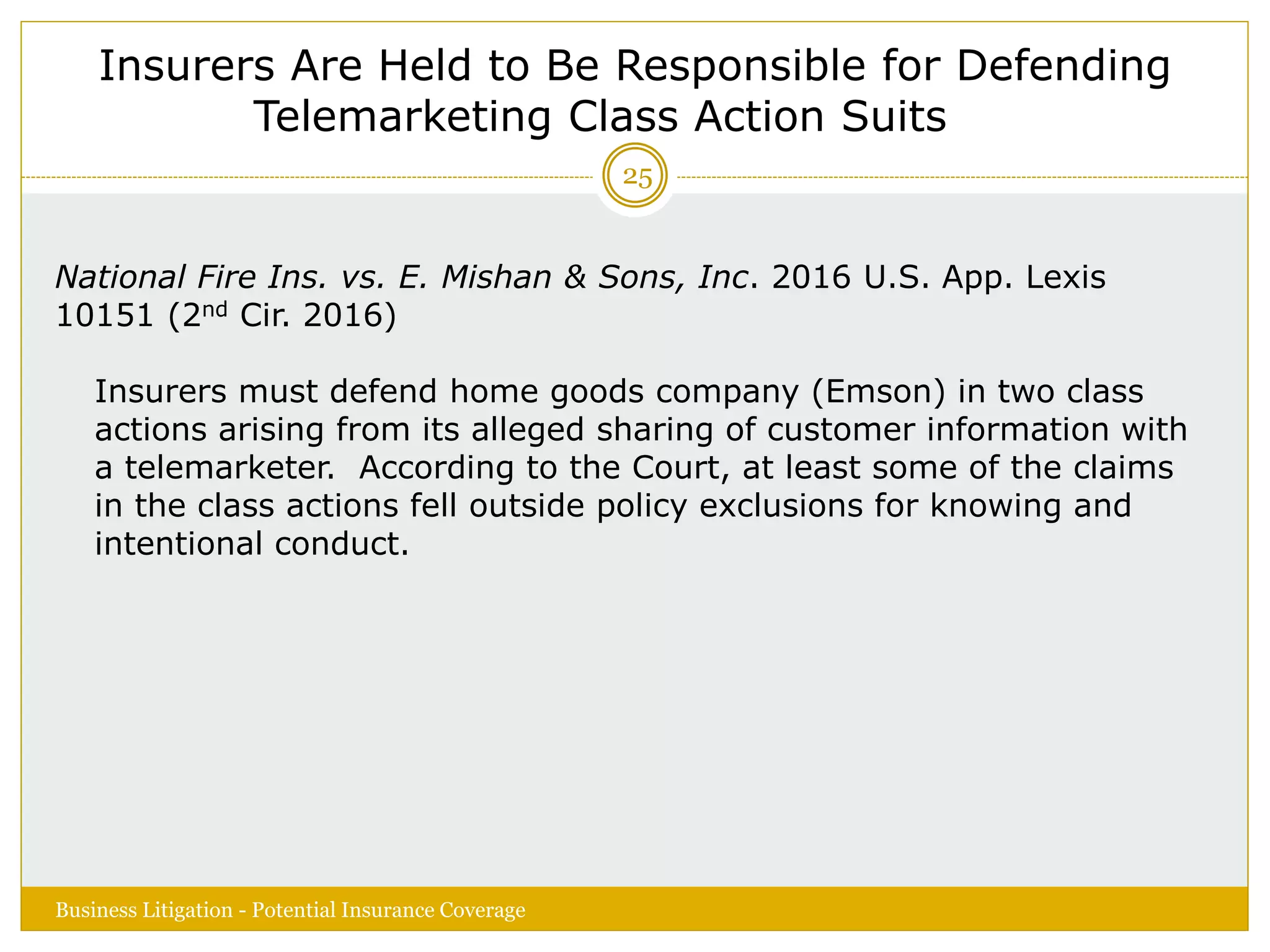
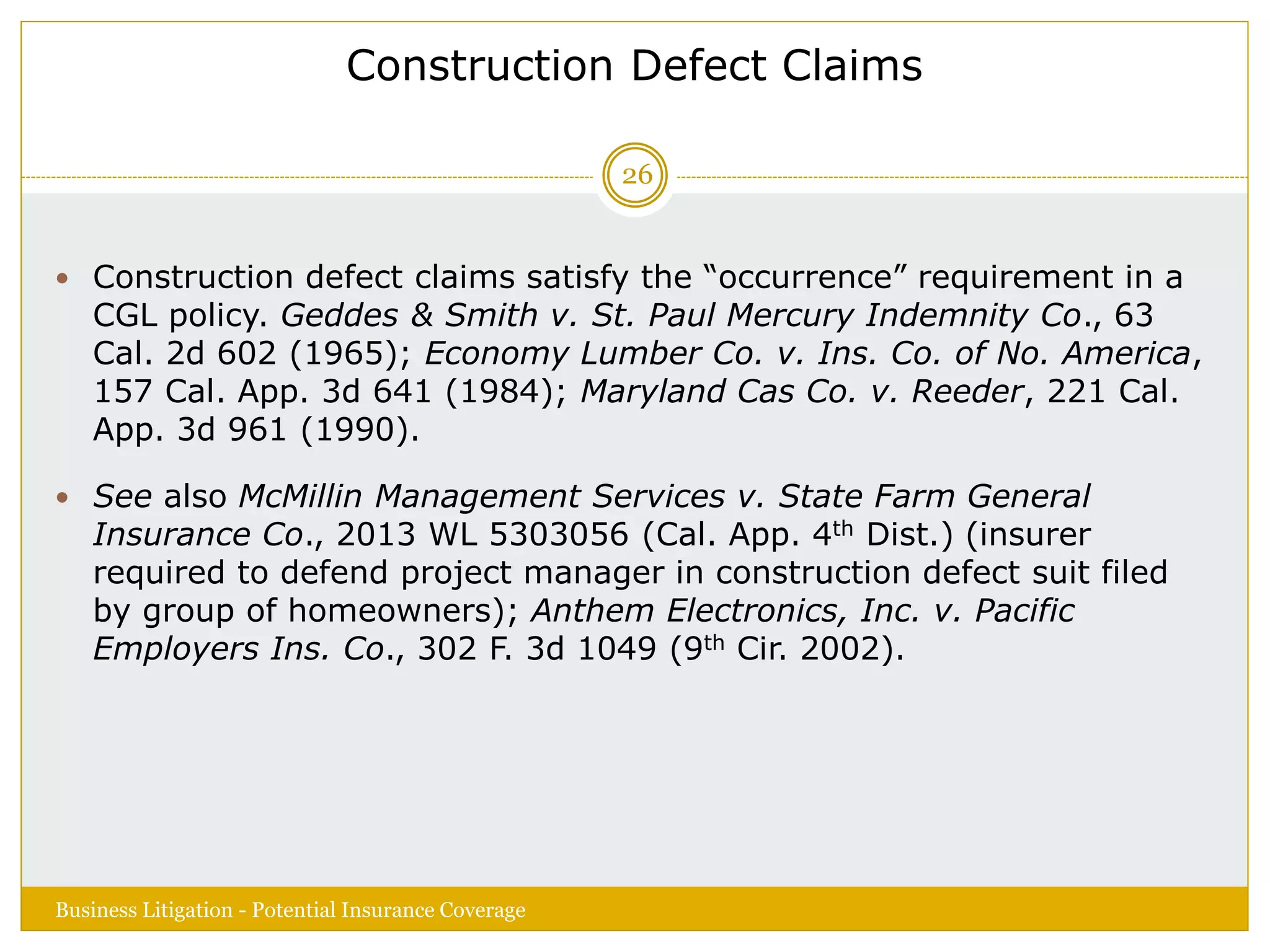
![Trade Dress Claims
Recognizing that a product’s design or appearance may inherently
also constitute a form of “advertising,” several courts have held that
trade dress inherently constitutes “advertising” within the meaning of
a CGL policy.
See St. Paul Fire and Marine Ins. Co., v. Advanced Interventional Systems, 824 F. Supp.
583, 585 (E.D. Va. 1993), affirmed 21 F. 3d 424 (4th Cir. 1994) (holding that trade dress
infringement “expresses essentially the same concept” as the term “style of doing
business”); Poof Toy Products Inc. v. U.S. Fid. & Guar. Co., 891 F. Supp. 1228, 1232
(E.D. Mich. 1995) (trade dress infringement constitutes “advertising injury” under the
advertising injury “offense” or “misappropriation of advertising ideas or style of doing
business”); Peerless Lighting Corp. v. American Motorists Ins. Co., 82 Cal. App. 4th 995,
1000, fn 4 (2000) (“infringement of trade dress arguably qualifies as ‘[m]isappropriation
of advertising ideas or style of doing business.’”)
Business Litigation - Potential Insurance Coverage
27](https://image.slidesharecdn.com/d14c790d-eea7-4d96-99a2-c8f1aa71ea31-161012172533/75/Selvin_Potential-Insurance-Coverage-27-2048.jpg)
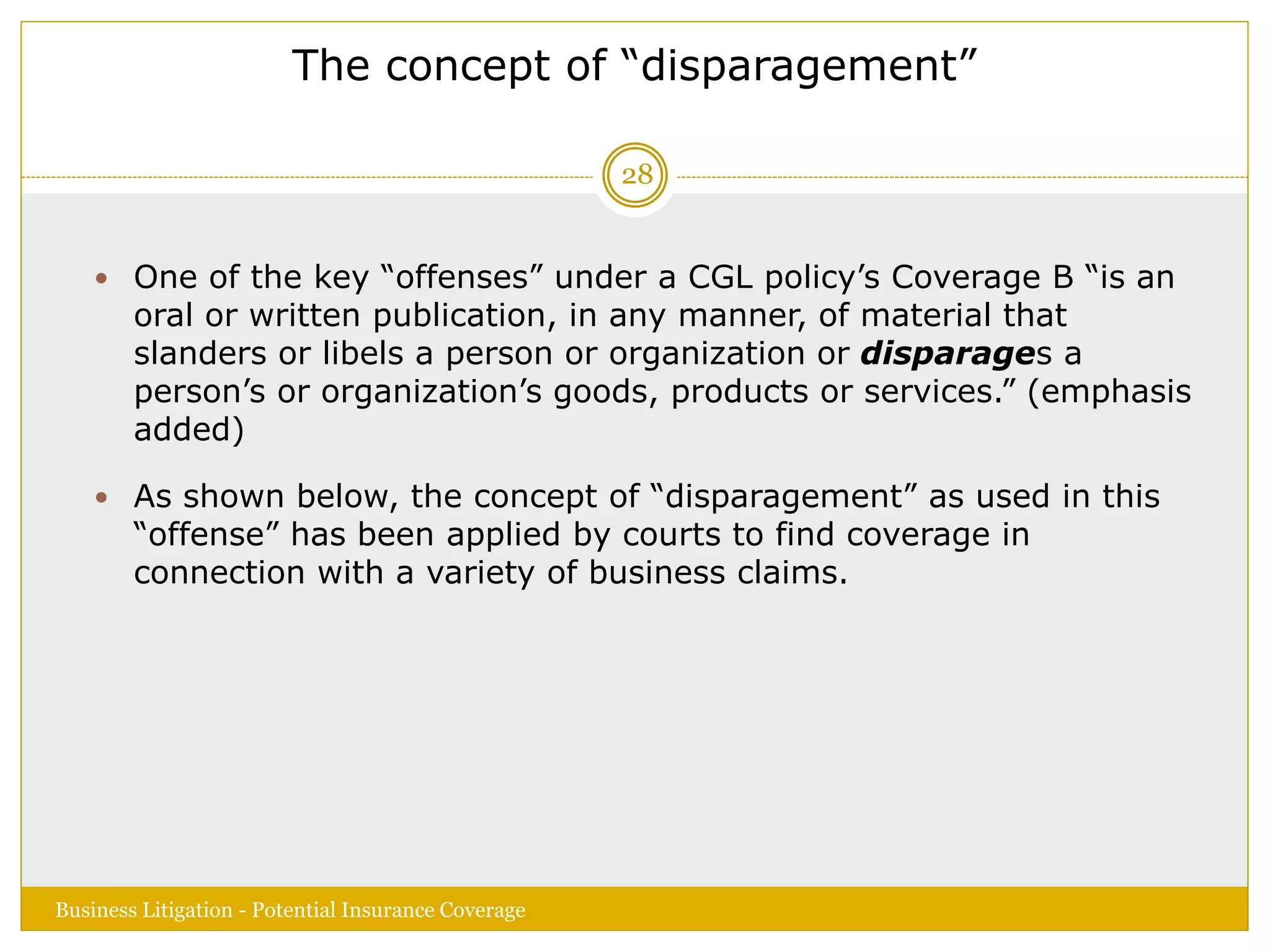
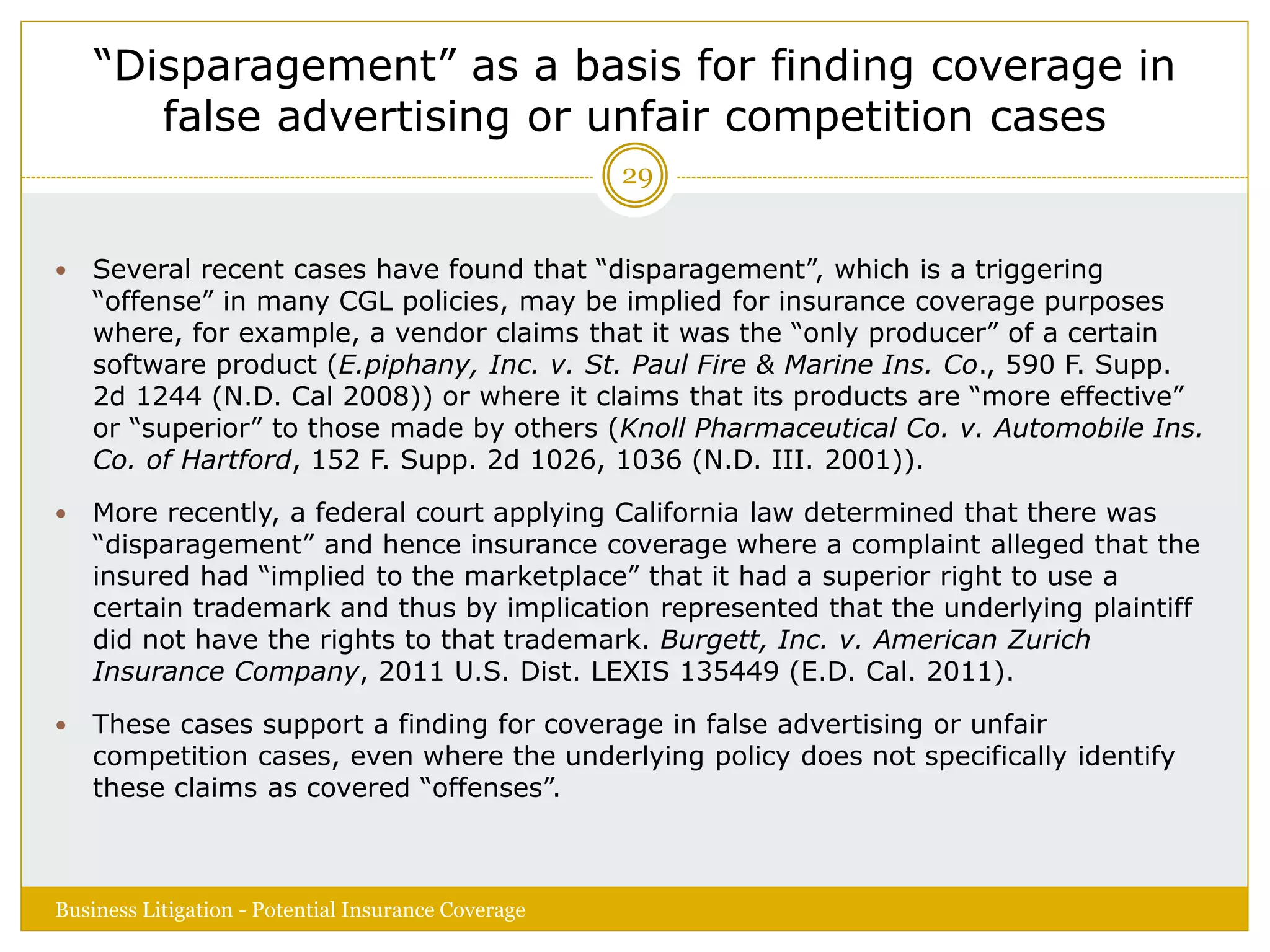
![The California Supreme Court Decision In Hartford
Casualty v. Swift Distribution, 59 Cal. 4th 277 (2014)
But in 2014 the California Supreme Court significantly limited the
doctrine of “implied disparagement” in the insurance coverage context:
“In evaluating whether a claim of disparagement has been
alleged, courts have required that defendant’s false or misleading
statement have a degree of specificity that distinguishes direct
criticism of a competitor’s product or business from other
statements extolling the virtues or superiority of the defendant’s
product or business…[This] involves two distinct … requirements.
A false and misleading statement (1) must specifically refer to
the plaintiff’s product or business, and (2) must clearly derogate
that product or business”. Id. at 291.
Thus, an insured’s attempt to copy or infringe on the intellectual
property of another’s product does not, without more, constitute
disparagement. Id. at 296.
Business Litigation - Potential Insurance Coverage
30](https://image.slidesharecdn.com/d14c790d-eea7-4d96-99a2-c8f1aa71ea31-161012172533/75/Selvin_Potential-Insurance-Coverage-30-2048.jpg)
